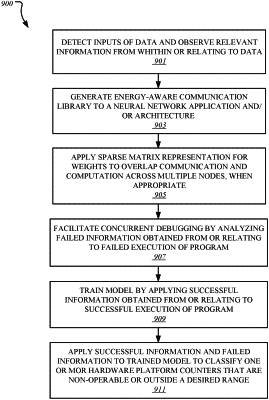| CPC G06N 3/063 (2013.01) [G06F 9/46 (2013.01); G06N 3/044 (2023.01); G06N 3/045 (2023.01); G06N 3/084 (2013.01); G06N 5/01 (2023.01)] | 25 Claims |

|
1. An apparatus comprising:
a graphics processor to:
cause a neural network application to implement a library comprising machine learning primitives, wherein the machine learning primitives are usable to analyze a skew pattern observed in a distributed gradient synchronization implemented by the neural network application;
determine, using the machine learning primitives of the library, a point to apply frequency scaling in the graphics processor without degrading performance of the neural network application, the point determined based on analysis of the skew pattern generated by the distributed gradient synchronization; and
determine, using the library as implemented by the neural network application, a core frequency of the frequency scaling applied at the point, wherein the library is to account for skew characteristics associated with the distributed gradient synchronization to decide the core frequency.
|